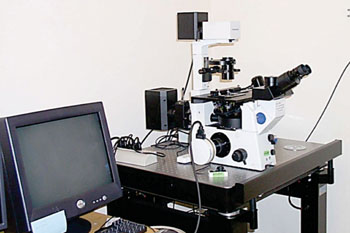Luminescent Nanocrystal Tags Enable Multiple Pathogen Detection
By LabMedica International staff writers
Posted on 21 May 2014
The use of tunable luminescent nanocrystals as tags to advance medical imaging has been successfully applied to high-speed scanning technology and can detect multiple viruses within minutes.Posted on 21 May 2014
A way to control the length of time light from a luminescent nanocrystal lingers, has been developed which introduces the dimension of time in addition to color and brightness in optical detection technology. Detection based on the lifetime of the light from a nanocrystal as well as its specific color exponentially increases the possible combinations and unique tags that could be created for biomedical screens.

Image: An IX71 inverted microscope with epi-fluorescence used for time-resolved orthogonal scanning automated microscopy (Photo courtesy of Macquarie University).
Scientists at Macquarie University (Sydney, Australia) and Purdue University (West Lafayette, IN, USA) attached unique tags to DNA strands of human immunodeficiency virus (HIV), Ebolavirus, Hepatitis B virus, and Human Papillomavirus 16. The tags were accurately read and distinguished at high speeds in suspension arrays.
To further extend optical time-domain multiplexing to the down conversion luminescence, they used luminescence microspheres where lifetimes are tuned through luminescence resonance energy transfer. They decoded luminescence lifetimes in the microsecond region for lanthanide-encoded suspension arrays. This was accomplished by time-resolved orthogonal scanning automated microscopy (TR-OSAM) modified on an epi-fluorescence Olympus IX71 inverted microscope (Olympus America; Center Valley, PA, USA).
The authors concluded that they were able to demonstrate that luminescence lifetimes of microscopic targets in the microsecond region can be measured rapidly and precisely in a simple fashion. Their TR-OSAM system was rapid, sensitive and accurate in resolving the luminescence lifetimes from individual microspheres prepared by the luminescence resonance energy transfer scheme, which can be used to simultaneously probe multiple analytes, such as DNA strands.
Yiqing Lu, PhD, who led the study said, “We now are able to build a huge library of lifetime color-coded microspheres to perform multiple medical tasks or diagnoses at the same time. The time saved by omitting the need to grow or amplify a culture sample for testing and eliminating the need to run multiple tests will save future patients precious time so treatment can begin, which can be life-saving when managing aggressive diseases.” The study was published on May 6, 2014, in the journal Nature Communications.
Related Links:
Macquarie University
Purdue University
Olympus America




 assay.jpg)








